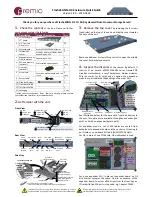
■
Recommended RAID Level
Recommended RAID levels are RAID5 and RAID6.
For SSDs, a RAID5 configuration or a fault tolerant enhanced RAID6 configuration is recommended because SSDs
operate much faster than other types of drive. For large capacity SSDs, using a RAID6-FR configuration, which
provides excellent performance for the rebuild process, is recommended.
User Capacity (Logical Capacity)
User Capacity for Each RAID Level
The user capacity depends on the capacity of drives that configure a RAID group and the RAID level.
shows the formula for calculating the user capacity for each RAID level.
Table 6
Formula for Calculating User Capacity for Each RAID Level
RAID level
Formula for user capacity calculation
RAID0
Drive capacity
´
Number of drives
RAID1
Drive capacity
´
Number of drives
¸
2
RAID1+0
Drive capacity
´
Number of drives
¸
2
RAID5
Drive capacity
´
(Number of drives - 1)
RAID5+0
Drive capacity
´
(Number of drives - 2)
RAID6
Drive capacity
´
(Number of drives - 2)
RAID6-FR
Drive capacity
´
(Number of drives - (2
´
N) - Number of hot spares) (*1)
*1:
"N" is the number of RAID6 configuration sets. For example, if a RAID6 group is configured with "(3D+2P)
´
2+1HS", N is "2".
User Capacity of Drives
shows the user capacity for each drive.
Table 7
User Capacity per Drive
Product name (*1)
User capacity
960GB SSD
914,432MB
1.92TB SSD
1,830,144MB
3.84TB SSD
3,661,568MB
7.68TB SSD
7,324,416MB
15.36TB SSD
14,650,112MB
30.72TB SSD
29,301,504MB
*1:
The capacity of the product names for the drives is based on the assumption that 1MB = 1,000
2
bytes, while the user capacity for each
drive is based on the assumption that 1MB = 1,024
2
bytes. Furthermore, OS file management overhead will reduce the actual usable
capacity.
The user capacity is constant regardless of the encryption support (SED).
2. Basic Functions
RAID Functions
24
Design Guide
Содержание ETERNUS AF S3 Series
Страница 204: ......
















































